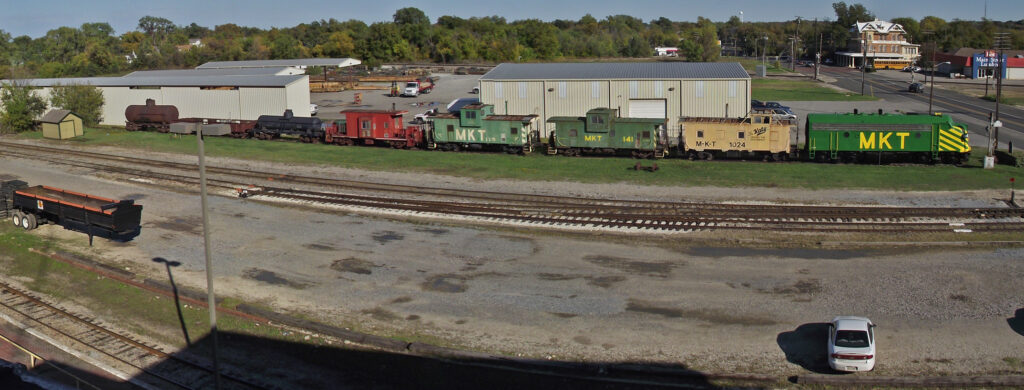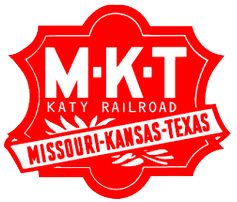Welcome to the Red River Railroad Museum Rolling Stock Display

THE LOCOMOTIVE:
Seven new model F3 locomotives emerged from the General Motors Electro-Motive Division plant at La Grange, Illinois, in the summer of 1947. Resplendent in cardinal red, silver gray, and yellow, they were the first freight diesel locomotives ordered by the Missouri-Kansas-Texas Railroad.
Each of the seven consisted of three 1,500 HP units two cab units with controls spliced by a booster, or blind unit for a total of 4,500 HP. One of the 21 units number 203C would become famous and outlast the others.
The seven locomotives went into service right away, replacing the venerable Mikado-type steam locomotives pulling the M-K-T Lines premier freight train, the famed Katy Komet from St. Louis to Texas, as well as the Katy Klipper from Kansas City, and other fast freight trains. The engines continued in this service for the next several years.
New management dictated that freight trains should be longer. Thus the three-unit consists were no longer up to the task, so the sets were broken up and mixed with diesels of other types to form engine consists of four, five, six, or more units. Additionally, the units were repainted solid red and given new numbers. Unit 203C became engine 66C; she and her sisters were scattered but continued to serve many more years. Another management change resulted in Katy historic red livery being dropped in favor of green with yellow stripes arond 1972.
By 1980, 66C was the only one of the original 21 units left on the roster, all the others having been sold, traded, or scrapped. But 66C got a new lease on life after a catastrophe fire. The ingenious forces at the M-K-T Parsons, Kansas locomotive shop were well known for extending the life of worn out locomotives by converting them into something else useful. They even created a new locomotive by combining the remains of two wrecked engines. 66C was radically changed both inside and out into something unique. There never has been and never will be another like her. Internally, she was converted from a Model F3 to the equivalent of a model GP38-2, with higher horsepower and newer electrical components. The cab windows were covered because 66C was now to be a booster or blind unit. The controls and cab floor were removed and a tall door cut in the nose to allow crewmen to pass through the unit easily. 66C was painted solid green and given a new number. First as 399B and then as the 401B, she remained in regular use until the Union Pacific Railroad took over the Katy in 1988 and ended her four decades of service. The 401B is the only surviving example of the Katy’s covered wagons which doomed the steam engine to the cutting torch and scrap yards.
Today, the veteran 401B resides at the Red River Railroad Museum in Denison, Texas, having earned her retirement and the affection of countless railroad fans.
THE CABOOSES:
The caboose provided the train crew with a shelter at the rear of the train. They could exit the train for switching or to protect the rear of the train when stopped. They also inspected the train for problems such as shifting loads, broken or dragging equipment, and hot boxes. The conductor kept records and handled business from a table or desk in the caboose. For longer trips the caboose provided minimal living quarters, and was frequently personalized and decorated with pictures and posters.
Coal or wood was originally used to fire a cast iron stove for heat and cooking, later giving way to a kerosene heater.Originally lit with oil lamps, later caboose versions incorporated an electrical generator driven by belts coupled to one of the axles, which charged a lead-acid storage battery when the train was in motion.
Cabooses were non-revenue equipment and were often improvised or retained well beyond the normal lifetime of a freight car. Tradition on many lines held that the caboose should be painted a bright red, though on many lines it eventually became the practice to paint them in the same corporate colors as locomotives.
Cabooses are no longer used on railroads as automation and radio control of equipment has reduced the number of people required to operate a train.To many rail fans, the demise of the caboose is the most visible sign of how much our world is changing.
The museum displays four cabooses, of three types.The first three in our lineup are similar and were called standard and extended view cupola cabooses.The yellow one was built in Denison in 1947 by the MKT Denison car shops.The red one is a type called a transfer caboose.A transfer caboose looks more like a flat car with a shed bolted to the middle of it than it does a standard caboose. It is used in transfer service between rail yards or short switching runs, and as such, often lacks sleeping, cooking or restroom facilities. The ends of a transfer caboose are left open, with safety railings surrounding the area between the crew compartment and the end of the car.
OTHER ROLLING STOCK:
The museum also displays several other rail cars, including two tank cars and a gondola.� Some of these types of cars are still in common use on railroads today.� One of the tank cars is the last one of its type still in existence.
Acknowledgements:
Brochure design by:Mike Shaw
401B Locomotive article by:Harry R. Brown
Brochure photos and updated text by:Roy V. Jackson
Please feel free to take this description home with you.If you have questions, feel free to contact us for more information.We invite you to visit us again and bring your family and friends.
